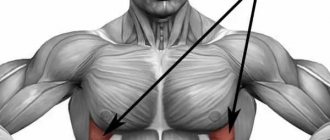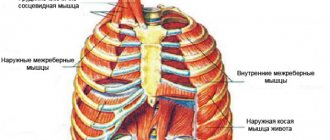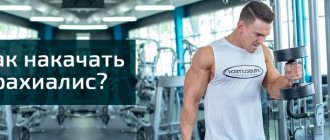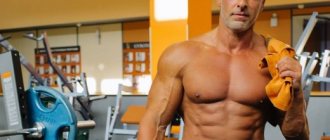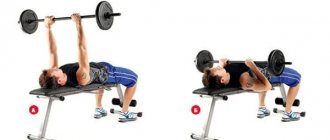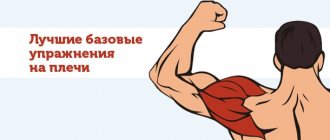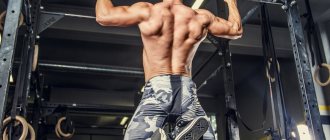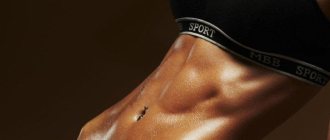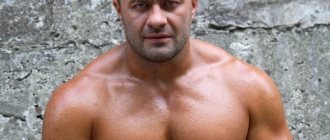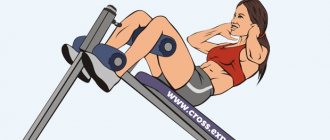Fitness programs almost always lack exercises for the serratus anterior muscle. From the point of view of working out all muscle groups, it is not so large as to add separate exercises for working out. However, from an anatomical point of view, the serratus anterior muscle performs important functions, and therefore needs training no less than other muscles. Also, with sufficient hypertrophy and a low percentage of subcutaneous fat, it allows you to create an excellent athletic appearance, emphasizing the relief of the chest and abs. Prominent serratus muscle has become a hallmark of many athletes, so devoting sufficient attention to training it will bring you a number of benefits.
Anatomy and location of the serratus anterior muscle
Serratus anterior muscle location
The serratus anterior muscle has a flat structure. It is quite wide, and its distinctive feature is the “teeth”, which is how it got its name. The location of the serratus muscle on the chest is the anterolateral section of the chest wall.
The upper part is covered by the pectoralis major, so only a small part of it can be visually assessed. Moreover, it is this part that lends itself best to hypertrophy (that is, when performing exercises on the serratus muscles, only by this part can you visually assess progress).
The muscle starts from the I-IX ribs, moving backwards and upwards. It covers the ribs along an arc, from 8-9 teeth of the ribs to the tendon arch between the I-XI ribs. Attaches to the ventral surface of the medial part of the scapula (between the lower and upper corners).
Anatomically there are three parts:
- Superior – located in the area of 1-2 ribs.
- Intermediate – located in the area of 2-3 ribs, with a shift towards the scapula.
- Inferior - the largest bunch, from 4 to 9 ribs. It is considered the strongest part (when it comes to training the serratus muscles and hypertrophy, this is what they mean).
Start and Attachment
The PSM originates on the anterior surface of the eight or nine upper ribs and is inserted on the medial border of the scapula.
We recommend reading: How often should you eat?
Conventionally, this muscle is divided into three parts:
- Upper: 1st-2nd rib → upper corner of the shoulder blade.
- Middle: 2nd to 3rd rib → medial edge of scapula.
- Inferior: from the 4th to the 9th rib → medial edge and lower angle of the scapula. This is the most powerful and outstanding part.
Innervation and blood supply
The PZM is innervated by the long thoracic nerve (C5-C7 roots of the brachial plexus). The blood supply to this muscle is provided by the lateral thoracic, superior thoracic and thoracodorsal arteries.
Functions of the serratus anterior muscle
The main function of the serratus anterior muscle is to abduct the shoulder blades. The main antagonist is the trapezius muscles. Muscle functions, depending on the bundle:
- Moving the scapula forward and laterally (mainly the lower angle).
- Rotation of the scapula around the sagittal axis to lift the arm above the horizontal level (lower fascicles).
- Raising the ribs with a strengthened scapula (promotes expansion of the chest).
When the muscle is weak and underdeveloped, a “pterygoid scapula” is formed. The function of shoulder abduction and flexion also becomes more difficult and worsens.
Features of the training
In fitness, there are no secret exercises to pump up your serratus muscles. They are involved in most movements that are aimed at developing the pectoral, deltoid and back muscles. The muscle is also partially involved in some abdominal movements. Therefore, you can often come across the wording “serratus abdominal muscles” (although anatomically it is not correct).
The main problem on the way to pronounced hypertrophy of the desired muscle is its function. It is very difficult to perform a movement in which the rest of the muscles do not take on the entire load. This requires special conditions when performing exercises, as well as carefully selected weight (mostly the work is carried out with light weights).
The main sports in which this muscle is involved:
- Strength sports (bodybuilding, weightlifting, powerlifting).
- Swimming (works in all styles and techniques).
- Disciplines where there are throwing and pushing elements.
- Artistic gymnastics (while holding on rings, uneven bars, etc.).
- Martial arts and other sports in which the shoulder girdle is actively involved.
In most disciplines, the muscle develops naturally. You should pay attention to pumping up the serratus anterior muscle only if it is clearly lagging behind, which leads to worse results in sports.
Therefore, the main sport in which muscles are trained to increase volume is bodybuilding. Mostly we are talking about a competitive career, where the form can give an additional advantage and give aesthetics to the figure in some positions.
It is also worth noting that the pronounced serratus muscle in professional bodybuilders is largely the result of competent posing than targeted development. Genetics also plays an important role, which determines the shape (for some athletes it stands out noticeably even without additional exercises).
Effective exercises for developing deltoid muscles
The deltoid muscles consist of three main bundles: anterior (clavicular part), middle (acromial part), posterior (spinous part). Every day, when moving your arms, the front delta works, so it receives less attention during training than others. It is more difficult to develop the side “bunches” responsible for the width of the shoulders. The back area, which forms the volume, is very difficult to pump. An exceptionally balanced load on the muscles gives an ideal spherical relief of the shoulders. It is recommended to do exercises for a specific group of deltas on separate training days. This approach is more effective than giving the load to only one group.
Rules for training
Before classes whose exercises are designed for the deltoid muscles, you need to familiarize yourself with the basic training requirements:
- classes are held 1-2 times a week;
- you need to start with warm-up exercises to warm up the muscles, for this you simply use less weight;
- Presses have a greater effect than swings;
- it is preferable to work with free weights than on machines;
- work the rear delts first;
- at least one of the basic exercises (for example, rows to the chin) should be included in the training;
- correct technique for performing exercises;
- select the weight according to the rules, for example, the famous bodybuilder Labrada, who believes that the weight should be taken 10% lower than that used in the previous approach;
- uniform work of the shoulder, back and pectoral muscles.
Some fans of strength training have the misconception that you should first work out the pectoral and back muscles, and only then work on the deltoids, but it is their underdevelopment that becomes the reason that inhibits the development of neighboring muscle groups. After all, for deadlift exercises, bench presses and others, well-developed deltoid muscles are needed.
Training to develop the anterior deltas
It is necessary to give intense load to the anterior bundles, using the highest working weight with an average number of repetitions. In this case, the dumbbells or barbell are lowered less sharply at a slower pace. To develop the frontal muscle group:
- press the barbell/dumbbells from the chest (three sets with six repetitions each);
- press dumbbells according to the Arnold system (three sets of eight repetitions);
- take turns, or together lift dumbbells/barbell in front of you (three twelve each).
Middle delt training
It is recommended to combine approaches of the front and middle deltoids with the muscle group of the back/legs, and the rear deltoids with the pectoral muscles. The most effective exercises are:
- barbell chest push-ups (sets of 3 x 6 reps);
- press-up with dumbbells in a sitting position (3 to 8);
- standing, dumbbells are lifted from the sides (3 to 12 - 15).
Working out the rear delts
This area is very difficult to work through, which is why these deltas remain undeveloped for some time for beginners. There are few effective exercises for them. These are the most commonly used:
- in a lying position, face down, dumbbell rows (3 to 10);
- bend forward, lift dumbbells (three by fifteen) through the sides.
Where to train to properly work the deltoid muscles?
Many sports clubs have sections with strength training, where they welcome everyone who wants to be strong, resilient and with a beautiful body. Pay attention to the improvement and equipment of the gym, the professionalism of the trainers, programs and training schedule. As a rule, in good sports clubs there is always an attentive and individual approach to clients. All you have to do is focus on training.
If the results from training in the gym are insufficient, you can additionally visit the pool, fitness, play tennis, learn martial arts to work out all the muscles, incl. back spine area
.
Author: K.M.N., Academician of the Russian Academy of Medical Sciences M.A. Bobyr
Top 5 exercises to train the serratus anterior muscle
Despite the fact that the serratus anterior belongs to the back group (according to its function), the area is used primarily in exercises for training the pectoral. The most effective movements for loading are:
- Pullover with a dumbbell (movement number 1 to pump up the serratus muscles) .
- Bench press (on a flat or incline bench, also with a downward incline press).
- Standing presses with dumbbells or barbell.
- Breeding with dumbbells in a lying position (on a horizontal or inclined bench).
- Pull to the chin (“broach”).
Deep back muscles[edit | edit code]
Deep back muscles, lumbar region[edit | edit code]
- Iliocostal lumbar muscle
- Intertransverse lumbar muscles
- Low back rotator muscles
- Multifidus lumborum muscle
Deep back muscles, thoracic region[edit | edit code]
- Iliocostal muscle of the chest
- Longissimus thoracis muscle
- Spinalis thoracis muscle
- Rotator muscles of the chest
- Multifidus chest muscle
- Semispinalis thoracis muscle
Deep back muscles, cervical region[edit | edit code]
- Iliocostal muscle of the neck
- Longissimus capitis muscle
- Longissimus colli muscle
- Splenius neck muscle
- Splenius capitis muscle
- Spinalis neck muscle
- Spinalis capitis muscle
- Rotator neck muscles
- Multifidus neck muscle
- Semispinalis neck muscle
- Semispinalis capitis muscle
- Rectus capitis posterior major muscle
- Rectus capitis posterior minor muscle
- Superior oblique capitis muscle
- Inferior oblique capitis muscle
